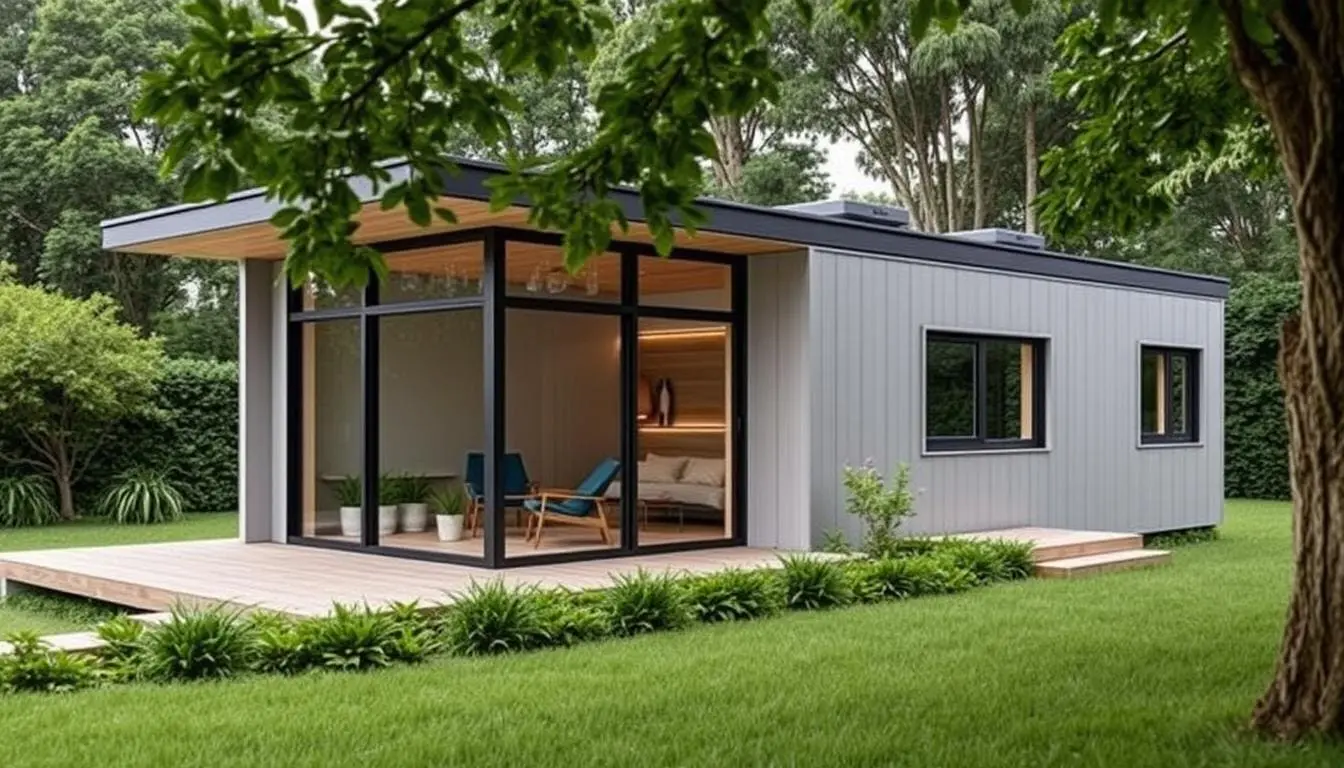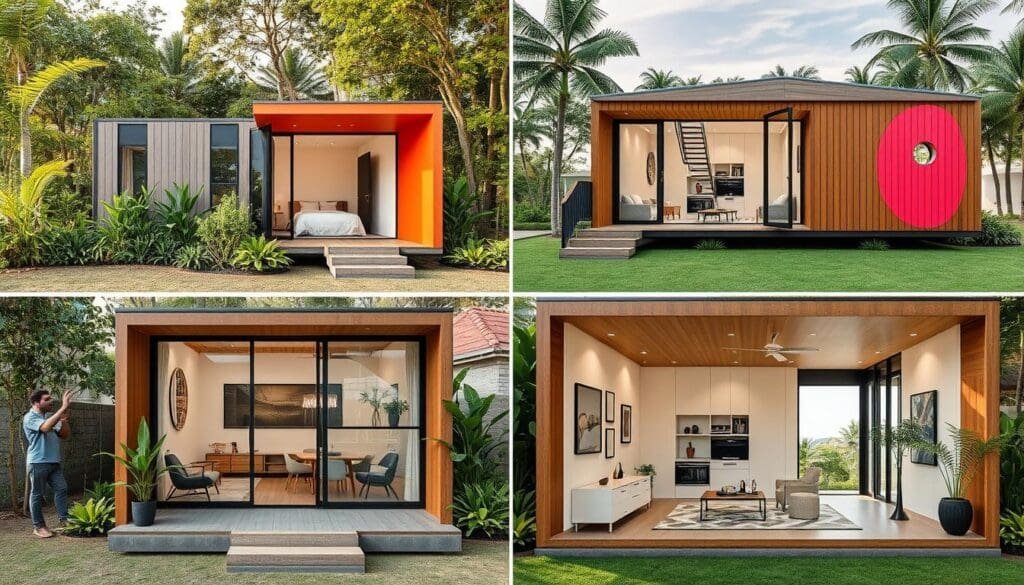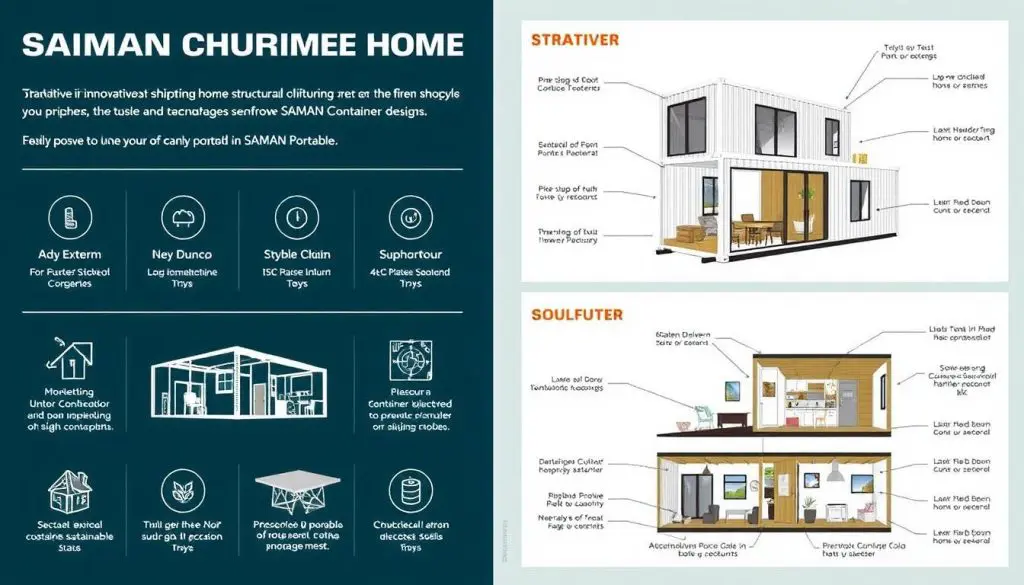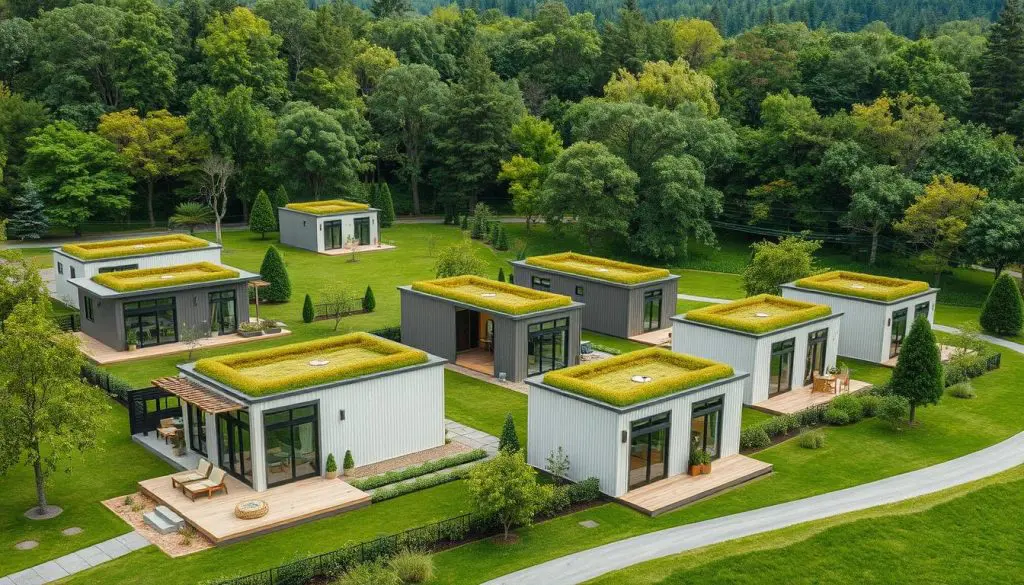Modern Modular Homes: Affordable, Stylish, and Eco-Friendly Housing Solutions

Are you tired of the high costs and long construction times of traditional homes? Modern modular homes are changing the game. They offer affordable, stylish, and eco-friendly options. These innovative homes are shaking up the real estate world, giving us a new look at sustainable living.
Key Takeaways:
- Modular homes are cheaper than traditional homes, costing 20-30% less per square foot.
- They can be built much faster, so you can move in sooner.
- Designed with the environment in mind, they use energy-efficient tech and eco-friendly materials.
- You can customize them to fit your style and needs.
- They meet high standards for safety and durability, making them ideal as durable modular homes.
So, what makes modern modular homes different? Let’s dive into the world of prefabricated homes. We’ll see why they’re becoming so popular. Get ready to think differently about your next home.
Understanding the Evolution of Prefabricated Housing
Prefabricated housing has changed a lot since its early days, showcasing modern prefabricated cabins. It’s now customizable dream homes. This change shows how technology and demand for affordable, green, and flexible homes have grown.
Historical Development of Modular Construction
The idea of prefabricated housing started in the early 20th century. It was used to quickly and affordably house soldiers returning from war in the 1940s. Since then, homes have become more energy-efficient, using sustainable materials and designs.
Technological Advancements in Manufacturing
Today’s prefabricated homes are made with new technologies. 3D printing and robotics are used in making them. They also come with smart home features and save energy. These changes have made homes better and more eco-friendly.
Current Market Trends
The demand for affordable, green, and customizable homes has risen due to modular housing benefits. Companies like SAMAN Portable have built over 400 homes in 50+ cities in India. They’ve covered more than 250,000 square feet of space. Now, there’s a big market for container-based office spaces, construction site offices, and modern portable office solutions too.

The future of prefabricated housing looks promising. It will focus on being affordable, sustainable, and customizable. This will meet the needs of today’s homeowners.
Cost Benefits of Modern Modular Homes
Choosing a modern modular home can save you a lot of money compared to building a traditional house. The way these homes are made in a factory and the bulk buying of materials cut down costs. For example, SAMAN Portable starts their homes at $260,000 for 958 square feet, or about $175 per square foot.
SAMAN Portable also offers eco-friendly, modular homes. They say most of their homes will cost $500-600 per square foot. This includes all the costs from the factory to the final landscaping.
These prices are much lower than what you’d pay for a traditional house. Modular homes are often 10-20% cheaper per square foot than stick-built homes. The factory-made process and less labor needed make them more affordable. This makes modern office cabins and affordable prefab homes available to more people.
Modular homes also save money in the long run. They use less energy, which means lower bills. They’re built faster, which can save on financing costs. Plus, they’re safer and more durable in natural disaster areas, which can lower insurance costs over time.
Sustainable Features and Environmental Impact
Modern modular homes focus on being green and caring for the planet. They use advanced energy-saving tech, eco-friendly materials, and cut down on waste. This makes them better for the environment.
Energy Efficiency Solutions
Companies like SAMAN Portable lead in making homes energy-smart. They use top-notch air filters and windows that save energy. This means lower bills for homeowners and less harm to the planet.
Eco-friendly Materials
SAMAN Portable is all about using green materials. They choose cork for floors, paints that don’t harm the air, and water savers. These choices make homes healthier and kinder to the earth.
Waste Reduction in Manufacturing
Building homes in a factory cuts down on waste, and also supports portable storage solutions. SAMAN Portable is a big name in this field. They focus on being green with their eco-friendly porta cabins and sustainable modular construction.

Modern modular homes are all about being green. They use smart energy solutions, eco-friendly materials, and reduce waste. This lets homeowners live comfortably without harming the planet.
Customization Options and Design Flexibility
Modern modular homes give homeowners many choices for customization and design. Companies like SAMAN Portable mix prefab and modular techniques with modern looks. SAMAN Portable creates homes and cottages that fit what clients want, with lots of options.
SAMAN Portable is like the Ikea of prefab and modular houses. It lets clients design their perfect homes. This means endless choices for making living spaces just right.
Modular homes can have open floor plans for better flow. They can also change layouts to fit different lifestyles. Custom designs mean homes are made just for what you need, like workshops or home gyms.
Customizing modular homes means using top-quality materials. This affects how they look and work. You can choose from different siding, roof styles, and even add porches or stone facades.
Upgrades like better siding, porches, and landscaping can make modular homes look great. They reflect your personal style.
Modular homes are great for growing families because they can be expanded. They’re built in a factory and then put together on-site. This saves time and reduces waste.

When customizing modular homes, think about what you need now and in the future. Choose layouts that fit your lifestyle and consider energy efficiency. Focus on materials and finishes that reflect your style. Modern modular homes let you create your dream space, whether it’s a customizable porta cabin or a modern portable office solution.
Construction Timeline and Process
Modular homes are built much faster than traditional houses. Builders can finish a modular home in about three months. This is much quicker than building a house on-site.
This speed comes from a special process. It combines building parts in a factory and then assembling them on-site.
Factory Production Phase
Most of the work, up to 80-90%, happens in a factory. Here, modules are made, plumbing and wiring are installed, and insulation is added. Design elements are also integrated.
This method ensures high quality and meets local building codes. It’s all about precision and consistency.
On-site Assembly
When the modules are ready, they’re moved to the site. There, they’re carefully placed and connected. This creates a solid and complete home.
At the same time, the site is prepared. This includes foundation work. It makes the assembly process smooth and efficient.
Final Finishing Details
The last steps are done on-site. This includes adding portable cabin for office and living or construction site office parts. It also finishes any interior or exterior details.
This approach not only saves time. It also avoids delays caused by bad weather, a big problem in traditional building.

Quality Control and Building Standards
At SAMAN Portable, we’re proud to offer top-notch modular homes. They meet the highest building standards. Our modern portable office solutions are made in cutting-edge facilities. Here, we follow the best design and workflow practices to ensure quality in every part.
Modular construction goes through tough quality checks at every step. From picking materials to putting it all together, we’re strict. Our quality assurance and control program is certified by county and state codes. This means our modular homes follow all the rules.
- Designated Quality Manager and a QA/QC Team oversee the entire production process.
- Streamlined communications and effective coordination among design teams, architects, site managers, and construction specialists are crucial for successful modular construction.
- Quality Assurance Surveillance monitors the quality of work throughout the project, with regular inspections and tests conducted to ensure the highest standards are met.
- A system for Non-conformance Control is in place to address and correct any issues, maintaining the integrity of our modern portable office solutions and high-quality modular homes.
Our team uses the controlled factory environment to make and assemble each part with precision. This ensures the quality our clients have come to trust from SAMAN Portable. In the world of modern modular homes, we aim to be the standard of excellence.

Modern Modular Homes: Features and Amenities
Modern modular homes are becoming more popular. They are affordable and sustainable. These homes come with advanced features and amenities for today’s homeowners.
Smart Home Integration
Smart home technology is a key feature of modern modular homes. Companies like Dvele offer systems like DveleIQ. These systems control energy use, air quality, and more.
They make homes more comfortable and energy-efficient. Homeowners can control their homes remotely.
Contemporary Design Elements
Modern modular homes also have stylish designs. Companies like SAMAN Portable focus on modern looks. They blend style with function.
These homes have energy-saving appliances and advanced air systems. They look good and feel comfortable.
Modern modular homes are changing the housing market. They offer smart features and stylish designs. They are becoming a top choice for those who want both function and style.

Site Requirements and Preparation
Building modern modular homes requires careful site preparation. This step is key for a smooth and successful installation. It ensures the home is built well and lasts long.
First, a detailed site assessment is done. This involves talking to clients, realtors, and experts. They look at the terrain, existing buildings, and utility access. This makes sure the site is right for modular home site preparation.
- Clearing the land of obstacles, including trees, rocks, and vegetation, is a vital step in the site preparation process.
- Ensuring the ground is level and stable is crucial for the successful installation of the modular units.
- Proper drainage around the foundation is essential to prevent structural issues and water damage.
Getting the right permits is also important. Companies like SAMAN Portable work with clients and local authorities. They make sure all legal steps are followed. This helps the portable cabin installation go smoothly and on time.

By focusing on site assessment and preparation, modular homes are built efficiently. This leads to quality, sustainable, and affordable homes. This focus is why modular construction is becoming more popular in Australia and worldwide.
Weather Resistance and Durability
In today’s world, extreme weather is more common. Modern modular homes are built to be strong against harsh weather. They use new construction methods and materials to last for many years.
Climate Adaptability
Modular homes can handle different climates, from hot to cold. They are built to stand up to strong winds, heavy rain, and snow. Durable modular homes can face winds up to 180 Kmph and snow loads of up to 2 feet.
Structural Integrity
Modular homes are made to be safe and strong. They meet or beat local building codes for safety. The factory environment and quality checks make them even stronger.
With care, weather-resistant porta cabins can last up to 50 years or more. They offer a reliable and long-lasting home.

Financing Options and Investment Value
Modern modular homes have financing options similar to traditional homes. Buyers can look into mortgages and construction loans. These prefab homes are known for their energy efficiency, durability, and low maintenance costs.
The National Association of Home Builders (NAHB) says modular homes cost less than site-built ones. This is because most modular homes are for owner-occupants, not for resale. This can mean better long-term value and potential appreciation.
Modular homes can save up to 20% on construction costs. An 1,800-square-foot modular home might cost between $180,000 and $360,000, averaging $270,000. In contrast, building a custom home can cost from $350,000 to over $1 million, showing modular homes are more affordable.
The modular housing industry benefits from buying materials in bulk. This lowers construction costs. Plus, modular homes are more energy-efficient and durable, adding to their value over time.
- Modular homes save about 15% compared to traditional homes, offering big cost savings for buyers.
- Mortgage lenders offer chattel loans for modular homes with as little as 5% down and a 20-year term. This makes financing easier for buyers.
- Modular homes tend to appreciate over time, providing a good return on investment based on local market conditions and property quality.

In summary, the financing options and investment value of modern modular homes make them a great choice. They are affordable and sustainable for eco-conscious and budget-savvy buyers looking for a practical living space.
Interior Design and Space Optimization
Designing the interiors of modular homes is an art form. These factory-built structures offer customization options. Homeowners can create spaces that fit their unique tastes and needs.
One big plus of modular home interiors is space optimization. Factory manufacturing allows for smart storage and multifunctional furniture. This is key for space-efficient porta cabins and smaller homes, where space is limited.
- Modular furniture, like that from IKEA, West Elm, and CB2, is often cheaper. This is because it’s made in standard sizes.
- Eco-friendly materials like bamboo, reclaimed wood, and recycled plastics are becoming more popular. They meet the growing demand for sustainable design in modular home interiors.
- The flexibility of modular design lets homeowners customize their spaces. They can choose colors, finishes, and furniture arrangements.
By using modular design principles, homeowners can make their living spaces both comfortable and functional. Whether it’s a small apartment or a large family home, modular homes offer stylish and sustainable living options.
Transportation and Assembly Logistics
The modular home revolution focuses on efficient transport and assembly. SAMAN Portable Office Solutions has perfected the art of panel sizes for easy truck or container loading. This allows for global delivery of these modular home transport solutions. The assembly is simple, fast, and easy, with panels lifted and screwed into place.
Vapor barriers are then applied to seal the building. This protects it from water and moisture. These porta cabin installation steps help make modular homes faster to build.
Delivery Considerations
Modular home makers like SAMAN focus on efficient transport. They make sure their products can reach any place easily. The size of the parts is chosen to fit compactly, saving space during transport.
This method cuts down on delivery costs and environmental harm. It makes modular homes a smart choice for homes and businesses.
Installation Requirements
- Preparation of the building site, including leveling and foundation work
- Precise crane placement and panel lifting for accurate positioning
- Secure fastening of modules using screws and other specialized hardware
- Application of vapor barriers and sealants to ensure weather-tight construction
- Final touches, such as exterior cladding and landscaping, to complete the installation
The modular construction is easy and user-friendly. This makes porta cabin installation efficient and with little disruption. This focus on detail and logistics makes modular homes a practical and green housing option.
Maintenance and Long-term Care
Maintaining a modular home is easier than traditional homes. The factory-made parts and quality materials mean less upkeep. Modular home maintenance is simple, letting homeowners enjoy their space with little effort.
Companies like SAMAN Portable offer long warranties, up to 20 years. By following the recommended maintenance, homes can last 50 years or more. The durable materials used mean less porta cabin upkeep is needed.
Regular checks and maintenance are key to keeping a modular home in good shape. This includes:
- Checking and cleaning gutters and downspouts
- Inspecting the roof for any loose or missing shingles
- Maintaining the HVAC system, including changing air filters
- Detecting and addressing potential plumbing leaks
- Ensuring the electrical system is in good working order
- Monitoring for any pest infestations and taking preventive measures
- Keeping the exterior landscaping well-maintained
For big maintenance jobs or special inspections, get help from experts. They know modular homes well and can offer great advice. Regular modular home maintenance keeps your home in great shape for years.
Comparing Traditional vs. Modular Construction
The need for affordable and sustainable homes is growing. This has made the debate between traditional and modular construction more important. Modular construction is seen as more cost and time efficient.
Cost Analysis
Modular homes are often cheaper because of factory production and less on-site labor. Studies show they can save over 20% compared to traditional methods. This is because of lower labor costs and less material waste in a factory setting.
Time Efficiency
Modular construction is very fast. It allows for off-site fabrication and on-site preparation at the same time. This makes modular projects finish in half the time of traditional ones.
While traditional construction offers more design freedom, modular homes are getting more customizable. This lets architects and homeowners create unique homes without losing the benefits of quick and efficient building. As the modular industry grows, it becomes a better choice for modern, affordable, and sustainable homes.
Legal Considerations and Building Permits
Modular homes face different legal rules in each area. But, there are common things to keep in mind everywhere. Modular homes must follow local building codes and zoning rules. The good news is, getting permits for modular homes is usually easier than for traditional homes.
It’s important for people looking to buy a modular home to work with experienced makers. They know the local laws well. They can help you get the right permits and make sure your home is legal. Sometimes, modular homes are seen as “temporary,” which can change the rules you need to follow.
Navigating Modular Home Regulations
- Learn about local building codes and zoning rules for modular homes in your area.
- Work with modular home makers who can help with permits and ensure your home is legal.
- Know that some modular homes might be seen as “temporary,” which can impact permits.
- Look into any special rules or guidelines for modular home regulations and porta cabin permits in your area.
By teaming up with experts and keeping up with local laws, you can get the permits you need for your modular home. This makes sure your home is installed right and you can enjoy all the benefits of modular living.
Conclusion
Modern modular homes are a new, affordable, and green way to house people in India. Companies like SAMAN Portable, and SAMAN Prefab, are at the forefront. They offer homes that are good for the planet, save money, and are built fast.
The demand for these homes is rising fast, thanks to new tech and a need for green homes. The UK can build 75,000 of these homes every year. India has seen a big jump in start-up investments in this field, up by 108%.
As the housing market changes, modern modular homes are becoming more popular. They offer quality, value, and care for the environment. With new tech and green materials, these homes are changing how we live affordably and sustainably.
FAQ
What are the key advantages of modern modular homes?
Modern modular homes are affordable and sustainable. They offer customization options and are built faster than traditional homes.
How have technological advancements impacted the modular construction industry?
New tech has made modular homes better and more efficient. This has led to homes that are well-designed and eco-friendly.
What are the cost benefits of choosing a modern modular home?
Modular homes are cheaper than traditional homes. They cost less per square foot and need less labor on-site.
How do modern modular homes prioritize sustainability and environmental responsibility?
These homes use energy-efficient solutions and eco-friendly materials. They also reduce waste in the manufacturing process.
What customization options are available for modern modular homes?
Homeowners can customize their modular homes. They can choose the design, layout, and features to fit their needs.
How does the construction timeline of modular homes compare to traditional construction?
Modular homes are built faster than traditional homes. Most of the work is done in a factory, making the on-site assembly quicker.
What quality control measures are in place for modern modular homes?
Modular home makers follow strict quality standards. This ensures every part of the home is consistent and well-made in the factory.
What features and amenities are typical in modern modular homes?
These homes often have smart home tech, modern designs, and energy-saving appliances. They also have advanced air filters for comfort.
How do site requirements and preparation impact modular home construction?
The site must be properly assessed and prepared for the home’s installation. This ensures a smooth construction process.
How do modern modular homes address weather resistance and durability?
These homes are built to withstand weather and are very durable. They have weather-proof membranes and can handle heavy loads.
What financing options are available for modern modular homes?
Financing for modular homes is similar to traditional homes. There are mortgages and construction loans, with potential for long-term value.
How do modern modular homes optimize interior design and space?
Modular homes focus on using space well. They have built-in storage and multi-functional areas for efficient living.
What are the key considerations for transportation and assembly of modular homes?
Companies optimize panel sizes and logistics for easy delivery and assembly. This saves time and effort.
What are the typical maintenance and long-term care requirements for modern modular homes?
Modular homes need less maintenance than traditional homes. Their factory-built parts result in tighter construction and better insulation.
How do modern modular homes compare to traditional construction in terms of cost and time efficiency?
Modular homes are more cost-effective and efficient than traditional homes. The factory production process and less on-site labor save time and money.
What legal considerations and building permits are involved in modern modular home construction?
Modular homes must meet local building codes and zoning rules. The permitting process can be easier due to their factory-built nature.
 Container Cafe
Container Cafe



























































































